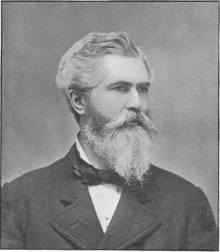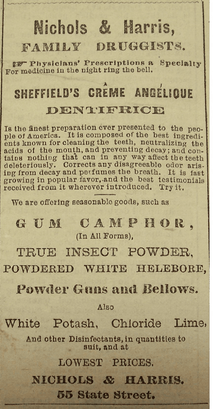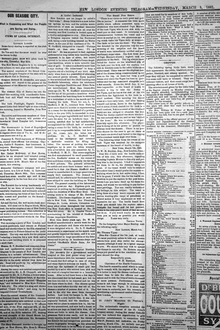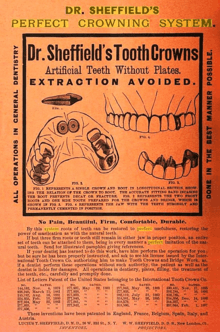Washington Sheffield
Washington Wentworth Sheffield (April 23, 1827 – November 4, 1897) was an American dental surgeon best known for inventing modern toothpaste. With the help of his son Lucius T. Sheffield, he was also the first to sell the paste in collapsible tubes. He also made important contributions to the fields of dentistry and dental surgery. He was considered one of the most skilled dentists in New England and the United States. In 1896, Colgate & Company began selling its own toothpaste that mimicked Sheffield's ready-made toothpaste and sold it in collapsible tubes like Sheffield.[1][2]
Washington Sheffield | |
|---|---|
 | |
| Born | Washington Wentworth Sheffield April 23, 1827 |
| Died | November 4, 1897 (aged 70) |
| Nationality | American |
| Other names | W.W. Sheffield |
| Occupation | Dental Surgeon |
| Known for | Inventor of Toothpaste |
Later in life, he spent most of his time as treasurer and manager of his companies, the Sheffield Dentifrice Company (which later became Sheffield Pharmaceuticals) and the International Tooth Crown Company, in New London, Connecticut.
Early life
Sheffield was born April 23, 1827 [3] in North Stonington, Connecticut, the third of eight children of the Reverend John Sheffield and Eliza (née Lewis) Sheffield who married Feb. 6, 1820.[4] Sheffield grew up in North Stonington, Connecticut, and was educated in its public schools.
Career

As was the custom in the 18th and early 19th century, Sheffield began his career in 1850 training as an apprentice dentist with J. A. G. Comstock of New London, Connecticut. He furthered his dentistry education in New York City by working under Charles Allen and D. H. Porter.[3]
In April 1852, Sheffield moved to New London, Connecticut[3] and began a long and successful practice in dentistry and dental surgery. Dr. Sheffield became one of the most successful dentists and dental surgeons in the United States. Sheffield graduated, in 1865, from the Ohio College of Dental Surgery, the second oldest dental school in the United States,[5] as a Doctor of Dental Surgery, see Figure 2. In 1866, Dr. Sheffield received a naval commission from the President of the United States, Andrew Johnson, as a dental surgeon.
Family


Sheffield married Miss Harriet P. Browne, daughter of Richard and Julia Browne of Providence, Rhode Island.[4] This marriage produced one child, a son, Lucius T. Sheffield (May 28, 1854 – September 20, 1901). Lucius Sheffield grew up in New London, Connecticut, and attended Norwich Free Academy. Lucius followed his father into dentistry and dental surgery. Lucius attended Harvard Medical School and graduated from Harvard's American Academy of Dental Medicine in 1878, see Figure 3. After graduation, from 1878 to 1879, Lucius traveled to Paris, France, to study and work in dentistry and dental surgery.
Lucius was in Paris watching artists prepare their paint palettes when he realized the collapsible tubes they used to squeeze paint onto palettes could be used to squeeze his father's toothpaste onto a toothbrush in a sanitary manner.
Inventions
Human beings recognized long ago the relationship between clean teeth and tooth decay and dental disease. The desire for clean teeth led individuals and later doctors and dentists to create teeth cleaning agents and tools. Tooth picks, toothbrushes and tooth powders were early inventions designed to satisfy the need to clean teeth. Cleaning agents for the teeth were often sold by doctors and early druggists. Figure 4 shows an early example ad for Rogers's Tooth Powder advertised in the Norwich Packet, May 6, 1800.
 Figure 4 - Roger's Tooth Powder
Figure 4 - Roger's Tooth Powder Figure 5 - Sheffield's Tooth Powder
Figure 5 - Sheffield's Tooth Powder
Tooth powder was popular up to World War II. Sheffield joined many doctors and dentists in formulating his own tooth powder for use on his patients and later as another product for his dentifrice company, see Figure 5.
Early in Sheffield's dental practice, he formulated a mouthwash which he used for years on his patients. When he and his son started the Sheffield Dentifrice Co. in 1880, they improved and reformulated that mouthwash and sold it as “Sheffield’s Elixir Balm” for the gums. Figure 6 shows early Sheffield products.
 Figure 6- A: Early Products of Sheffield Dentifrice Co.
Figure 6- A: Early Products of Sheffield Dentifrice Co. Figure 6- B: Illustration on top of crème dentifrice jar
Figure 6- B: Illustration on top of crème dentifrice jar
Based on contemporary news reports at the time, Sheffield conceived of a ready-made tooth crème in the mid-1870s and was using it on his patients with great praise from them. To this crème, he added various extracts of mints that left a very pleasing taste in the mouth of his patients which caused them to request samples of the toothpaste.[6]
Sheffield shared his toothpaste formula with his son who was a dentistry student at Harvard during this period. The oldest surviving toothpaste record within the Sheffield Pharmaceuticals’ archives, the successor to the Sheffield Dentifrice Co., is a notebook formula of the son, L.T. Sheffield, from 1878. L.T. Sheffield's notebook formula for toothpaste is seen in Figure 7.
 Figure 7A – L.T. Sheffield's 1878 notebook with amalgam formula page 1
Figure 7A – L.T. Sheffield's 1878 notebook with amalgam formula page 1 Figure 7B – L.T. Sheffield's 1878 notebook with toothpaste formula page 3
Figure 7B – L.T. Sheffield's 1878 notebook with toothpaste formula page 3
In response to toothpaste demands from patients, Sheffield started a manufacturing company, in early 1880.[6] Initially, Sheffield was making toothpaste batches at his dental office at the corner of State Street and Green Street in New London, Connecticut. Demand grew rapidly and he was forced to build a laboratory and manufacturing facility behind his residence.
 Figure 8 - First Toothpaste
Figure 8 - First Toothpaste Figure 9 – First Toothpaste Trademark, 1881
Figure 9 – First Toothpaste Trademark, 1881
The Sheffield Dentifrice Co. started producing his mouthwash and an entirely new product. Sheffield and his son called this product “Dr. Sheffield’s Crème Angelique Dentifrice”. This product was the first toothpaste and it was sold in collapsible tubes. An illustration of that first toothpaste is seen in Figure 8. Sheffield's son, now a Doctor of Dentistry, registered the trademark of that first toothpaste in 1881, see Figure 9.
The first advertisement ever published for toothpaste appeared on March 12, 1881 in the New London Telegram, see Figure 10.

The largest druggist in New London, at the time, was Nichols & Harris. The accounting ledgers from Nichols & Harris for the dates Dec. 25, 1880 to Oct. 26, 1881 have survived (Private Collection). Figure 12 show two of the earliest surviving records of the sale of the Sheffield's toothpaste in a tube.
 Figure 12 – Nichols & Harris Ledger, two of the oldest surviving records of the sale of Sheffield's “Crème Angelique” toothpaste, which was sold in collapsible tubes, A: Page 4 – December 28, 1880
Figure 12 – Nichols & Harris Ledger, two of the oldest surviving records of the sale of Sheffield's “Crème Angelique” toothpaste, which was sold in collapsible tubes, A: Page 4 – December 28, 1880 Figure 12 – Nichols & Harris Ledger, two of the oldest surviving records of the sale of Sheffield's “Crème Angelique” toothpaste, which was sold in collapsible tubes, B: Page 27 – January 15, 1881
Figure 12 – Nichols & Harris Ledger, two of the oldest surviving records of the sale of Sheffield's “Crème Angelique” toothpaste, which was sold in collapsible tubes, B: Page 27 – January 15, 1881
Figure 13 is a photograph of Sheffield's Laboratory, circa 1893. Modern day Sheffield Pharmaceuticals is located at that same site.

On March 7, 1882, a newspaper reporter for the largest newspaper in New London visited Sheffield at his laboratory on Broad Street in New London, Connecticut. The report of that visit was published on March 8, 1882, in The New London Evening Telegram newspaper, see Figure 14. The reporter describes the innovations L.T. Sheffield employed to get the “Crème Angelique” toothpaste into collapsible tubes.

In 1883, Sheffield revised the original “Crème Angelique” toothpaste formula. He called the revised formula “Dr. Sheffield’s Crème Dentifrice” toothpaste. This revised formula remained in production years after Dr. Sheffield's death in 1897. After 1900, the Sheffield Dentifrice Co. became a contract toothpaste manufacturer for many individuals and companies and has remained so to the present day.
From 1880 to 1892, the Sheffield Dentifrice Co. purchased collapsible tubes to package the toothpaste. Beginning in 1892, the company started manufacturing its own collapsible tubes by purchasing tube manufacturing presses and fabricating its own tube-making machinery. In 1900 the dentifrice company started a new company called the New England Collapsible Tube Co.[7] This was the fourth collapsible tube manufacturer in the United States.
During his career, Sheffield worked at the cutting edge of dental prosthetics. He specialized in dental bridges and tooth crowns. On May 26, 1885, Sheffield was granted patent No. 318,581 for a dental bridge to hold multiple crowns together on broken or decayed teeth. During that same period, Sheffield's son, L.T. Sheffield, DDM, received eight patents for various types of artificial dentures.
In 1886, Sheffield and his son formed the International Tooth Crown Company. Lucius T. Sheffield, DDM was president and W.W. Sheffield was treasurer. This company purchased the crown patents of two prominent dentists, James E. Low and Cassius M. Richmond. All these crown and bridge patents were combined under one company which the two doctors advertised as Sheffield's Perfect Crowning System, see Figure 15. Sheffield and his son received royalties from dentists around the world when they employed crowns and bridges covered under the Sheffields' patents.

References
- "Connecticut Famous People - Connecticut Inventors". Inventors.about.com. 2010-06-15. Retrieved 2011-12-17.
- "The Talk of the Town: Collapsible". The New Yorker. Retrieved 2014-01-30.
- Picturesque New London and Its Environs. American Book Exchange. 1901.
- Genealogical and Biographical Record of New London County, Connecticut. J.H. Beers & Co. 1905.
- A History of Dental and Oral Science in America, edited by James E. Dexter, 1876, p.179-181
- "A Local Industry". New London Evening Telegram. March 8, 1882. p. Vol. 9 No. 2795, page 4.
- The American Perfumer. Missing or empty
|title=(help)